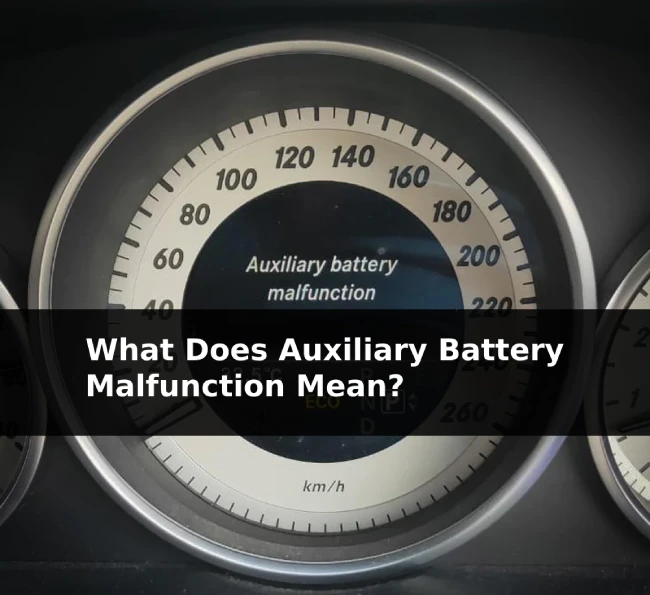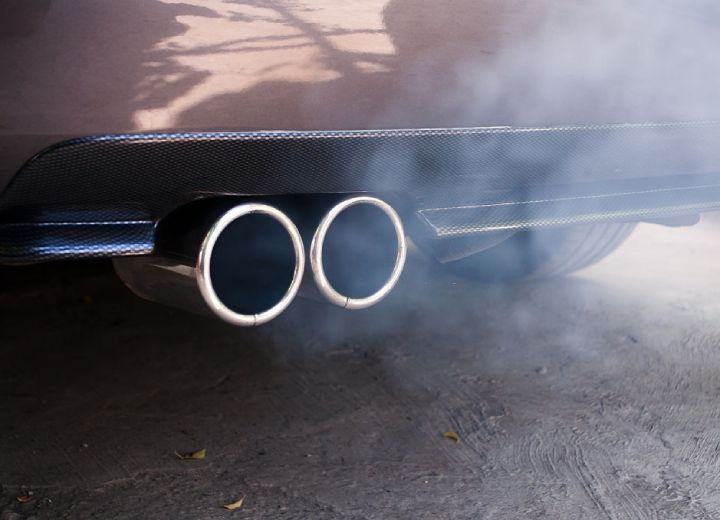Most cars come with just one 12V lithium-ion battery that powers the electrical components in the car. But with the ever-increasing number of gadgets and sophisticated devices in cars today, having just one battery is not enough.
This is the case with the Mercedes Benz where some models are equipped with the standard 12V battery and an auxiliary battery. The standard battery in the Mercedes Benz is located under either the right or left side of the hood, depending on the model. Its main duty is to start the engine.
- Here's What The Auxiliary Battery Does In A Mercedes
- Why Does the Mercedes Have an Auxiliary Battery?
- What Happens If the Auxiliary Battery Dies?
- Can Mercedes Run Without the Auxiliary Battery?
- How Often Should You Change the Auxiliary Battery?
- How Long Can a Car Last on an Auxiliary Battery?
- Can You Jump-Start Off the Auxiliary Battery?
- Conclusion

Here’s What The Auxiliary Battery Does In A Mercedes
The auxiliary battery serves as a backup to the main battery, and its function varies depending on the model of Mercedes you drive. In some models, the auxiliary battery is simply an electrical storage unit referred to as a capacitor or voltage converter, while for other models, the auxiliary battery is more than just a backup power supply. It also helps to power some electrical components in the car.
The location of the auxiliary battery depends also on the model of the car.
Common locations of the auxiliary battery for the Mercedes are at the engine bay (below the air intake), under the front passenger seat and behind the driver’s seat, and in the trunk.
Why Does the Mercedes Have an Auxiliary Battery?
Depending on the model, the auxiliary battery serves different functions. The Eco start/stop function is one of many features of the Mercedes that is powered by the auxiliary battery. This feature prevents idling by turning off the engine automatically when the car is stationary for a given length of time.
This means situations where a driver will normally idle, the engine will go off thereby reducing emissions and conserving fuel. The feature automatically activates when the brake pedal is engaged by the driver. As soon as the brake pedals are disengaged, the engine will turn on again.
The auxiliary battery also supplies power to important functions of the vehicle such as the emergency parking function, lights, audio system, AC, and different driving assist functions. For some models, the auxiliary battery is only needed after the car starts because there is a drop in voltage of about 3 to 4 volts when the vehicle starts.
At this point, the main battery is completely discharged and unable to supply power to the vehicle. So the auxiliary battery steps in to fill this role until the main battery are fully charged and back online.
What Happens If the Auxiliary Battery Dies?

If the main battery in the Mercedes is bad, you will quickly notice that it becomes difficult to start the car. For the auxiliary battery, the situation is a bit different. This is because the auxiliary battery is not involved in starting the car. Rather, it plays a secondary role in backing up the main battery. This does not mean that a bad auxiliary battery will go unnoticed.
Even if the auxiliary battery isn’t bad, a faulty charging circuit can prevent the battery from charging causing it to drain easily. In that case, the vehicle’s ECU will detect it and trigger an error message. The type of error message you receive will depend on the model of your Mercedes. Three common error messages have been reported indicating a faulty battery. These are:
- Auxiliary battery malfunction – common for older models
- Stop Vehicle Leave Engine Running – could also indicate an issue with the main battery
- Stop Vehicle Shift To P Leave Engine Running – also associated with the main battery as well
Along with these error messages, you may see a battery icon on the dashboard. This can be red or orange. The red battery icon signals that the battery isn’t charging and the orange one comes up when the battery’s voltage is low. If you see any of the icons, the problem might not be with the battery itself but with the charging system.
Some drivers report solving the problem by replacing the alternator. However, a good way to know for sure where the problem is coming from is by scanning your car with a diagnostic tool like the DTC. If the auxiliary battery is dead, you will get feedback with the code “9092 (some report says 9062) Component G1/7 (Auxiliary battery is defective or not installed.”
Since the auxiliary battery also powers some of the electrical components in the car, you will find out that these components no longer function if the battery dies. This may include the radios, lights, GPS, gear shift selector, ECO start/stop function, and several driving assist functions. The exact component that will be affected depends on the model of the Mercedes you drive. These are the symptoms of a bad auxiliary battery in the Mercedes.
Can Mercedes Run Without the Auxiliary Battery?
Yes. You should have no problem driving your Mercedes even if the auxiliary battery is bad. However, it is not always advisable to do so. The reason is that the auxiliary battery, despite being regarded as a secondary battery, is very important if you want your car to run smoothly. Apart from the loss of some functions in the car, you may experience other issues such as difficulty cranking up the engine. Yes, the main battery is usually responsible for this, but a problem with the auxiliary battery as I’ve explained can be caused by the electrical circuit.
If the circuit is short or the alternator is faulty, the batteries will not charge as they should. Then it’s only a matter of time before the main battery and the auxiliary battery are depleted. If this happens, your car could go off as several electrical components shut down simultaneously. To avoid this, you should visit a mechanic and get the auxiliary battery checked out as soon as possible.
How Often Should You Change the Auxiliary Battery?
The auxiliary battery lasts as long as the main battery, despite being smaller in size and capacity. The average lifespan of the battery falls within four to six years depending on usage. Before the battery fails, there are some tale-tale signs such as dimming headlights, power fluctuations, swelling and leakage (for non-AGM batteries), hard start, and the need to jump-start the car becoming more frequent. Speaking of jump-starting, although it is a common practice among drivers, it is not possible to jump-start the auxiliary battery. This is mainly because of its location. However, jumps-tarting the main battery is possible.
The problem is that when you use the main battery to the extent that it is completely drained and needs to be jump-started, its performance will deteriorate and the battery will not last long. When the main battery begins to deteriorate, it places more load on the auxiliary battery.
The increased demand for power will likely drain the auxiliary battery faster. If this continues, the auxiliary battery will start showing signs of deterioration as well. Along with draining the battery completely, excessive heat and vibrations can also shorten the lifespan of the auxiliary battery.
How Long Can a Car Last on an Auxiliary Battery?
Okay, so your main battery is disabled (for any reason) and you have to rely on the auxiliary battery alone. It is good to know just how long it can hold up. The first thing you have to consider is why the main battery failed. If this is a problem with the charging unit, then the auxiliary battery will not last very long. However, if the main battery is dead but the charging unit still functions as it should, then you won’t be in any immediate distress.
The auxiliary battery was put in place for a situation like this. It will likely take over some functions of the main battery (depending on the model). However, there is a limit to what the auxiliary battery can do. For instance, you won’t be able to start the car using the auxiliary battery and if the load happens to be too much, then the auxiliary battery may fail as well.
Can You Jump-Start Off the Auxiliary Battery?
The auxiliary battery is charged by the main battery. When the voltage drops considerably, the auxiliary battery relay is activated and current flows from the main battery to the auxiliary battery. Monitoring this process is the Master control unit or Signal actuation and acquisition unit known as SAM.
SAM monitors and controls the voltage and temperature of the auxiliary battery and determines when to open or close the charging circuit. The main battery in turn is being recharged by the alternator which only functions when the car is running.
Looking at this, it is easy to see that the only way to jump-start the car is through the main battery terminals and not the auxiliary battery. Apart from the complex charging system, the location of the auxiliary battery also makes it quite difficult to access. Additionally, for Mercedes models with voltage converters, it is completely impossible to jump-start the vehicle through this means since they are storage units and not actual batteries.
Conclusion
The function of the auxiliary battery varies from one Mercedes model to another. Some units only function as capacitors to supply additional power to the main battery when needed. Others offer more support by helping to power certain features of the car.
The standard auxiliary battery installed in the Mercedes is a 12V absorbent glass mat (AGM) battery that could cost up to $500 to replace. Although the price is quite steep relative to the size of the battery, its role as a backup/alternate power source makes it an important accessory to have in your car.
Iliah is the co-founder of Mechanic Ask, where he writes detailed step-by-step tutorials for repairs and mods. He also posts videos walking through things like engine swaps, suspension lifts, and tuning chips. Iliah uses his blog as an educational resource for car enthusiasts based on the knowledge he’s gained from 15 years as an ASE-certified master technician. His repair manuals provide even novice readers the confidence to take on big projects.








